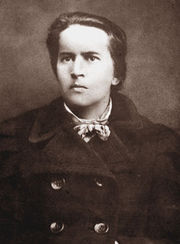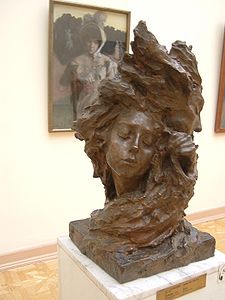
Anna Golubkina
Encyclopedia

Russia
Russia or , officially known as both Russia and the Russian Federation , is a country in northern Eurasia. It is a federal semi-presidential republic, comprising 83 federal subjects...
n impressionist sculptor. As the first Russian sculptor to receive the Paris Salon
Paris Salon
The Salon , or rarely Paris Salon , beginning in 1725 was the official art exhibition of the Académie des Beaux-Arts in Paris, France. Between 1748–1890 it was the greatest annual or biannual art event in the Western world...
prize, she is regarded as the first female Russian sculptor of note. Golubkina also had an exhibition at the prestigious Alexander III Museum
Pushkin Museum
The Pushkin Museum of Fine Arts is the largest museum of European art in Moscow, located in Volkhonka street, just opposite the Cathedral of Christ the Saviour....
. A crater
Golubkina (crater)
Golubkina is a crater on Venus.Golubkina is characterized by terraced inner walls and a central peak, typical of large impact craters on the Earth, Moon and Mars. The terraced inner walls form at late stages in the formation of an impact crater, due to collapse of the initial cavity formed by the...
on Venus
Venus
Venus is the second planet from the Sun, orbiting it every 224.7 Earth days. The planet is named after Venus, the Roman goddess of love and beauty. After the Moon, it is the brightest natural object in the night sky, reaching an apparent magnitude of −4.6, bright enough to cast shadows...
is named after her.
Biography
Anna was born in ZarayskZaraysk
Zaraysk is a town and the administrative center of Zaraysky District of Moscow Oblast, Russia, situated about southeast from Moscow. Population: The town stands on the right bank of the Osyotr River, which is a right confluent of the Oka...
, Ryazan
Ryazan
Ryazan is a city and the administrative center of Ryazan Oblast, Russia. It is located on the Oka River southeast of Moscow. Population: The strategic bomber base Dyagilevo is just west of the city, and the air base of Alexandrovo is to the southeast as is the Ryazan Turlatovo Airport...
gubernia (currently Moscow Oblast
Moscow Oblast
Moscow Oblast , or Podmoskovye , is a federal subject of Russia . Its area, at , is relatively small compared to other federal subjects, but it is one of the most densely populated regions in the country and, with the 2010 population of 7,092,941, is the second most populous federal subject...
), Russia to a family of peasant Old Believers
Old Believers
In the context of Russian Orthodox church history, the Old Believers separated after 1666 from the official Russian Orthodox Church as a protest against church reforms introduced by Patriarch Nikon between 1652–66...
. Her father died when Anna was only two years old. She was raised by her grandfather, Policarp Sidorovich Golubkin, who was a profitable vegetable farmer and probably the head of the local Filippians
Filippians
Filippians or Philippians was a soglasiye of the Bespopovtsy strain of Old Believers. They detached themselves from Pomortsy under the leadership of a "teacher" Filipp at the beginning of the 18th century...
community.
Anna did not receive even a primary school education until the age of 25. Despite their total lack of formal schooling, all the children in Golubkin's family were literate and Anna's older sister Alexandra later got a nurse (feldsher
Feldsher
Feldsher is the name of a health care professional who provides various medical services in Russia and other countries of the former Soviet Union, mainly in rural areas...
) diploma. Anna's talents in painting and sculpture were discovered by the local art teacher, who recommended that she go to Moscow to study art.
In 1889 she took entrance exams for Otto Gunst's Classes for Elegant Arts, an architecture school. Having no formal education, she failed some exams; but an examiner, sculptor Sergey Volnukhin, challenged other examiners to name a sculptor able to produce anything like her 'Praying old woman'. He convinced them not only to admit Anna, but to waive her tuition as well.

Moscow School of Painting, Sculpture and Architecture
The Moscow School of Painting, Sculpture and Architecture was one of the largest educational institutions in Russia. The school was formed by the 1865 merger of a private art college, established in Moscow in 1832, and the Palace School of Architecture, established in 1749 by Dmitry Ukhtomsky. By...
where she studied from 1890-1894 under Professor Sergey Ivanov. One of her classmates was another famous sculptor Sergey Konenkov
Sergey Konenkov
Sergey Timofeyevich Konenkov was a famous Russian and Soviet sculptor. He was often called "the Russian Rodin".-Early life:...
.
In 1894-1895 she studied at the Imperial Academy of Arts
Imperial Academy of Arts
The Russian Academy of Arts, informally known as the St. Petersburg Academy of Arts, was founded in 1757 by Ivan Shuvalov under the name Academy of the Three Noblest Arts. Catherine the Great renamed it the Imperial Academy of Arts and commissioned a new building, completed 25 years later in 1789...
in Saint Petersburg
Saint Petersburg
Saint Petersburg is a city and a federal subject of Russia located on the Neva River at the head of the Gulf of Finland on the Baltic Sea...
in the studio of famous sculptor Vladimir Beklemishev. According to researchers, Vladimir was the subject of Anna's tragic unrequited love, but never knew about it.
In 1895 she went to Paris where she studied at the Académie Colarossi
Académie Colarossi
The Académie Colarossi is an art school founded by the Italian sculptor Filippo Colarossi. First located on the Île de la Cité, it moved in the 1870s to 10 rue de la Grande-Chaumière in the VIe arrondissement of Paris, France....
(1895–1897). At that time Russian artists usually went abroad either having some sort of a stipend or sufficient independent income. Anna was one of the first of those who came to Paris having almost no money. She literally starved but managed to produce significant sculptures including 'The Iron One'.
In 1897, she briefly returned to Russia, then became an assistant to Auguste Rodin
Auguste Rodin
François-Auguste-René Rodin , known as Auguste Rodin , was a French sculptor. Although Rodin is generally considered the progenitor of modern sculpture, he did not set out to rebel against the past...
(1897–1900) taking the position of Camille Claudel
Camille Claudel
Camille Claudel was a French sculptor and graphic artist. She was the elder sister of the poet and diplomat Paul Claudel.- Early years :...
(she got an offer from Mark Antokolski
Mark Antokolski
Mark Matveyevich Antokolski was a Russian sculptor who was admired for psychological complexity of his historical images and panned for occasional lapses into sentimentalism.-Biography:...
as well). Rodin requested her work on the hands and legs of his sculptures. At that time, she also produced 'The Old Age', 'The Fire', The Mist and many other original sculptures. In The Old Age she employed a direct allusion with the work of Rodin himself. She used the same model, sitting in the same pose as Rodin's The Thinker
The Thinker
The Thinker is a bronze and marble sculpture by Auguste Rodin, whose first cast, of 1902, is now in the Musée Rodin in Paris; there are some twenty other original castings as well as various other versions, studies, and posthumous castings. It depicts a man in sober meditation battling with a...
which he created 14 years earlier.
In 1901, she returned to Moscow. Her bas relief The Wave installed on the facade
Facade
A facade or façade is generally one exterior side of a building, usually, but not always, the front. The word comes from the French language, literally meaning "frontage" or "face"....
of Moscow Art Theatre
Moscow Art Theatre
The Moscow Art Theatre is a theatre company in Moscow that the seminal Russian theatre practitioner Constantin Stanislavski, together with the playwright and director Vladimir Nemirovich-Danchenko, founded in 1898. It was conceived as a venue for naturalistic theatre, in contrast to the melodramas...
was considered a symbol of Russian Modernism
Modernism
Modernism, in its broadest definition, is modern thought, character, or practice. More specifically, the term describes the modernist movement, its set of cultural tendencies and array of associated cultural movements, originally arising from wide-scale and far-reaching changes to Western society...
. She participated in the Russian Revolution of 1905
Russian Revolution of 1905
The 1905 Russian Revolution was a wave of mass political and social unrest that spread through vast areas of the Russian Empire. Some of it was directed against the government, while some was undirected. It included worker strikes, peasant unrest, and military mutinies...
, was arrested and sentenced to one year in prison for distribution of leaflets and was freed due to her bad health. She also produced a number of sculptural portraits, including portraits of Andrei Bely
Andrei Bely
Andrei Bely was the pseudonym of Boris Nikolaevich Bugaev , a Russian novelist, poet, theorist, and literary critic. His novel Petersburg was regarded by Vladimir Nabokov as one of the four greatest novels of the 20th century.-Biography:...
, Alexei Remizov, Leo Tolstoy
Leo Tolstoy
Lev Nikolayevich Tolstoy was a Russian writer who primarily wrote novels and short stories. Later in life, he also wrote plays and essays. His two most famous works, the novels War and Peace and Anna Karenina, are acknowledged as two of the greatest novels of all time and a pinnacle of realist...
, and Karl Marx
Karl Marx
Karl Heinrich Marx was a German philosopher, economist, sociologist, historian, journalist, and revolutionary socialist. His ideas played a significant role in the development of social science and the socialist political movement...
.
Golubkina was initially very enthusiastic about the 1917 October Revolution
October Revolution
The October Revolution , also known as the Great October Socialist Revolution , Red October, the October Uprising or the Bolshevik Revolution, was a political revolution and a part of the Russian Revolution of 1917...
, but refused to work with the Soviet Government (including the Lenin's plan of Monumental propaganda) after the execution of the former members of the State Duma
State Duma
The State Duma , common abbreviation: Госду́ма ) in the Russian Federation is the lower house of the Federal Assembly of Russia , the upper house being the Federation Council of Russia. The Duma headquarters is located in central Moscow, a few steps from Manege Square. Its members are referred to...
. Eventually she agreed to teach in VKhUTEMAS
VKhUTEMAS
Vkhutemas ) was the Russian state art and technical school founded in 1920 in Moscow, replacing the Moscow Svomas. The workshops were established by a decree from Vladimir Lenin with the intentions, in the words of the Soviet government, "to prepare master artists of the highest qualifications for...
, where she would Tatar sculptor Baqi Urmançe
Baqi Urmançe
Urmançe Ğäbdelbaqí İdris ulı , Baqi Urmançe Идрис улы; , Urmanche Baki Idrisovich; 23 February 1897 - 6 August 1990) was a Tatar painter, sculptor and graphic artist, and a pedagogue...
.
Anna Golubkina died in 1927, while working on the sculpture of Alexander Blok
Alexander Blok
Alexander Alexandrovich Blok was a Russian lyrical poet.-Life and career:Blok was born in Saint Petersburg, into a sophisticated and intellectual family. Some of his relatives were literary men, his father being a law professor in Warsaw, and his maternal grandfather the rector of Saint Petersburg...
. She had surgery and was forbidden to handle heavy items. However, work on the large wooden sculpture required a lot of physical effort. Anna felt quite ill and went to Zaraysk to her sister, Alexandra Golubkina, expecting Alexandra to help her. She died a few days after arriving there.
Anna's studio in Moscow became a museum in 1932. It was the first Russian museum of that type.

